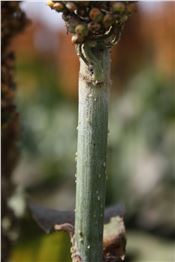Soybean And Sorghum
DR. SCOTT STEWART
JACKSON, TENN.
Although stink bug populations remain generally light, there are now some reports of populations exceeding the treatment threshold of 9 per 25 sweeps. Remember you should probably double this threshold once a field reaches R6. Calls are also trickling in about defoliation caused by green cloverworms, soybean loopers (particularly in the southern counties of middle and west Tennessee), and/or bean leaf beetles. The goal in to maintain defoliation levels at of below 20-25 percent before R6. You can relax this to 30-40 percent from R6 plus about 7 days and quit worrying about defoliation after this point. You will have to chose your insecticides to deal with the complex of pests that are present. Synthetic pyrethroids will not do an adequate job of controlling soybean loopers. Please refer to my previous article for insecticide selection when dealing with loopers.
Sorghum
All calls are now about sugarcane aphids and primarily deal with whether an insecticide should be added with the harvest aid to prevent build-up of honeydew and sooty mold on heads (potentially leading to problems during harvest). Aphids will often crawl to the heads as the plant begins to die after harvest aids are applied (pictured right). There is no established threshold, and it really comes down to some professional judgement. Don’t be too concerned about small hot spots of aphids scattered across the field. I would suggest that if aphids are easily found on most plants there is a risk of running into problems that could result in harvest delays such as periodically needing wash your combine or, in the worse case, clogging the combine. I would suggest treating if flag leaves are averaging 100 or more aphids because this almost always occurs when infestations are pretty substantial and aphids have spread across the entire field. Most people are electing to use Transform WG if adding an insecticide with their harvest aid. This is my recommendation as well. Transform provides less residual control that Sivanto, but you really don’t need much residual when tank mixing with a harvest aid. Transform at 1 oz/acre will be more economical than Sivanto at the minimum labeled rate (4 oz), and Transform has a shorter pre-harvest interval (14 days) than Sivanto (21 days). ∆
DR. SCOTT STEWART: IPM Extension Specialist, University of Tennessee

SCA-MoveTo Head